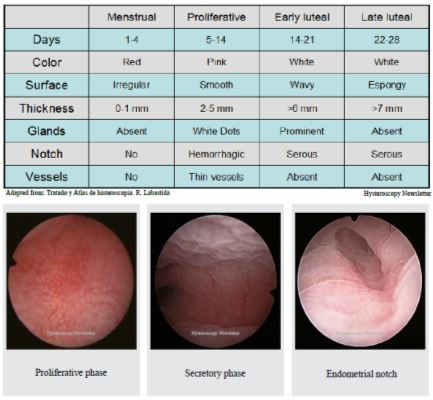These changes occurring during the endometrial cycle, give the endometrium different hysteroscopic patterns typical of each phase, allowing the assessment of normal “hysteroscopic” endometrial cycle.

1- Proliferative phase: the endometrium has a light pink color due to the presence of small vessels. The surface is smooth and glands are small and rounded, appearing as small and uniform dots. The endometrial notch is small and generally hemorrhagic.
2- Secretory phase: The endometrium has a pale pink color. The surface is slightly wavy and irregular. The glands are larger, open and rose at the level of the superficial layer. The vessels disappear from the endometrial surface due to stromal edema. The endometrium reaches its maximum thickness at this stage, showing a deep avascular endometrial notch.
3- Menstrual phase: the endometrium takes on a reddish color, with indentations and bleeding. In this phase there are alternating areas of detaching and well preserved endometrium.
Tank you Sir Loius Alfonso Pacheco for sharing us these educational videos i find it verry intresting i have appreciated the management of endometrial pathologies by hysteroscopic route in case for exemple of uterine myomas adenomyosis synechiae polyps fibrotic or mucous but i realize by the time we are still ignorance about endometrial cancer screening we hvae proposed different methods to diagnose these premalignant pathologies but with lack of studies but what i want to demonstrate is just my own scientific imagination i think it is mors better to use a Dye test wich is my main topic of new discovery the purpose of the use safe Dye test color using fluorescence method or other technic is to detect endometirial cytologic precancerous changes without any damage of uterine endometrial layer by dilatation and curetage wich can alterate histologic pattern of the disease can lead to false positif and false nagatif is this method can be the perspective of endometrial non invasive exploration thank you Professor